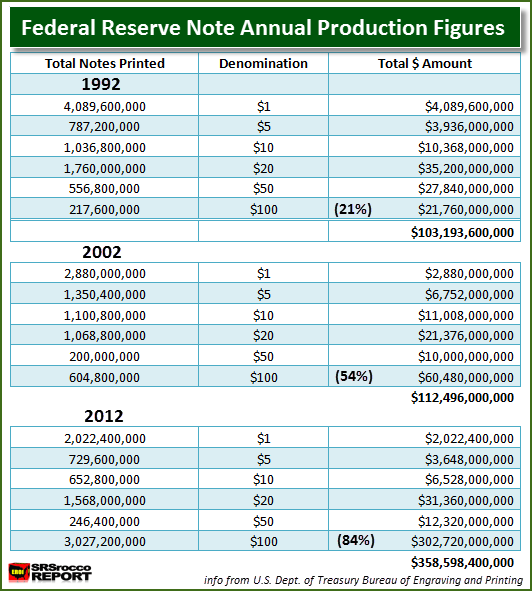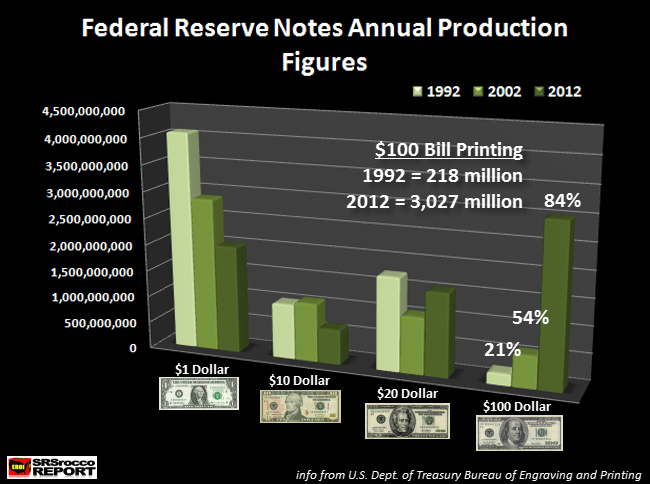Our fellow Outsider Steve St. Angelo (SRSrocco) has released an excellent new article, which he has shared with Outsider Club readers below:
It looks like the U.S. Treasury is learning a few tricks from the Reserve Bank of Zimbabwe as it ramps up its printing press. In just a few years, the U.S. Department of Treasury Bureau of Engraving & Printing has substantially increased the printing of its largest valued Federal Reserve Note — the $100 bill.
Ironically, the U.S. Department of the Treasury calls its Bureau of Engraving & Printing’s website, the MoneyFactory.gov. Who says government officials don’t have a sense of humor?
Why on earth should gold and silver miners spend $100′s of billions of dollars exploring, mining, extracting and refining to produce real money, when you can go to the U.S Money Factory and get all the money you need? And for pennies on the dollar.
According to the U.S. Treasury’s website:
During Fiscal Year (FY) 2013, the Bureau of Engraving and Printing delivered approximately 26 million notes a day with a face value of approximately $1.3 billion.
During Fiscal Year (FY) 2013, the Bureau of Engraving and Printing delivered approximately 6.6 billion notes at an average cost of 10 cents per note.
Over 90 percent of the notes that the BEP delivers each year are used to replace notes already in, or taken out of circulation.
The Bureau of Engraving & Printing releases annual data on the Federal Reserve Note production figures and the table below shows the changes from 1992-2012:
Now, if we concentrate on the most used Federal Reserve Notes, the $1, $10, $20 and $100, we can clearly see the change in annual production figures below:
You will notice that the two biggest changes are the large drop in production of $1 bills and the huge increase in the $100 note. In 1992, the Treasury printed a little more than $4 billion in $1 bills, but this fell in half to $2 billion in 2012. Now if we look at the change in the printing of the $100 bill, we have a much different story.
In 1992, the U.S. Treasury printed $103 billion worth of Federal Reserve notes and the $100 bill accounted for 21% of this total. Then in 2002, the total currency printed that year increased modestly to $112 billion, but the $100 bill was now 54% of this total amount. However, by 2012 a significant change took place.
Not only did the total value of currency printed in 2012 triple compared to 2002, but the majority of the increase was solely due to the printing of our famous American — Benjamin Franklin. In 2012 of the total $358 billion printed in Federal Reserve Notes, the $100 bill accounted for $303 billion, or 84% of this amount.
As you can see from the figures on the chart, the printing of the $100 has increased more than 10 fold from 218 million $100 bills in 1992 to 3,027 million printed in 2012.
While it’s true that the use of debt cards has reduced the need for the smaller bills such as the $1, $5 and $10, this doesn’t change the fact that amount of actual physical currency in circulation (in dollar amount) is now overwhelmingly the $100 bill. No wonder the U.S. Treasury had to redesign a new $100 bill to fight against the increased counterfeit threat.
To get ready for the “New Release” of its redesigned $100, the U.S. Department of Treasury, printed 563 million of the new bills just in the month of September (48 million of the $100 notes at its eastern facility and 515 million at its western branch).
The huge increase in the printing of the $100 bill this past decade coincides nicely with the massive increase of U.S. Govt debt and Federal Reserve policy of QE monetization. I would imagine if the new Federal Reserve Chairman, Janet Yellen keeps to her promise of increasing QE to infinity, they may have to bring back some of their old larger notes out of retirement.
Even though the $100,000 note is a gold certificate, it gives the reader a good idea of what a Federal Reserve Note would look like with all those extra zeros.
The United States is heading for a hyperinflationary collapse. This will not be an economic event, but rather a loss of faith in the Dollar — a statement repeated by Jim Sinclair.
Lastly, the world is facing two different collapses. One is a financial-paper collapse and the other is an energy-physical collapse. In the history of world, mankind has been able to pull itself out of all financial collapses whether they be hyperinflations, deflations or world-wide depressions.
However, we always had a growing energy supply to do so. This time will be different… indeed. We are heading into a new paradigm that I call, “COLLAPSE ECONOMICS.” I will explore this in detail in several future articles, the first to come out shortly.
The world will wake up abruptly one day to the forgotten monetary religion of Gold & Silver.
Our friend Steve St. Angelo (SRSrocco) is an independent researcher that started to invest in precious metals in 2002. Later on in 2008, he began researching areas of the gold and silver market that, curiously, the majority of the precious metal analyst community have left unexplored. These areas include how energy and the falling EROI – Energy Returned On Invested – stand to impact the mining industry, precious metals, paper assets, and the overall economy.
Steve considers studying the impacts of EROI one of the most important aspects of his energy research.
The SRSrocco Report will be putting out public and paid reports in the future that will explore, analyze and discuss how energy will impact the precious metals, mining and overall economy. We urge you to check out his research.




